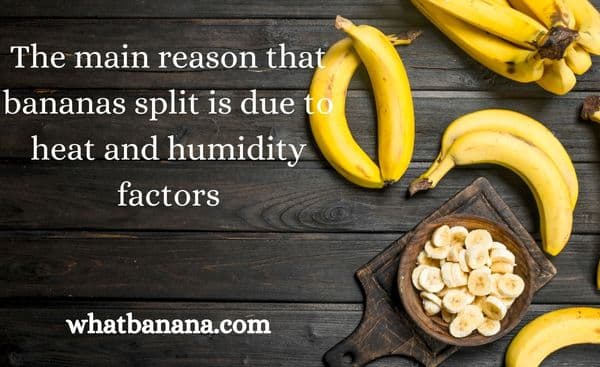It’s a question on every yellow-fruit-loving person’s mind, why do bananas split?
We’ve all been there.
You reach for your favorite fruit treat, and you notice a long split down the side.
Well, that split certainly wasn’t there when you bought it.
And your banana was definitely in one piece yesterday.
So, what gives?
Here’s why your banana has decided to pop open.
The main reason that bananas split is due to heat and humidity factors. If a banana is exposed to relative humidity levels over 90% and temperatures exceeding 21C (70F), they are more likely to split. This is especially true if they were left on the plant/tree for too long. Bananas should be cut down from the tree while still emerald green and extremely hard. They then go through a specific ripening process.
1. Heat and Humidity
You know that once you’ve purchased your bananas that you have anywhere between 2-7 days to eat them.
This will generally depend on how ripe (or unripe) they were when you bought them.
But I’m sure you’re also aware that environmental factors play their part.
In fact, during the hot summer months, you know it’s best to consume those bananas as quickly as possible.
If you don’t, then there’s a good chance they’re going to turn brown very quickly.
With that being said, they’ll still be okay to eat, just extremely soft and sweet.
However, heat, and especially humidity, play a huge role in why your bananas split open.
If a banana is exposed to high relative humidity in excess of 90%, as well as temperatures exceeding 21C (70F), they are more likely to split.
To make matters worse, if bananas are exposed to fluctuating temperatures and humidity, they are more prone to splitting.
So, where you store them can also have an impact.
As an example, if your bananas are stored near your cooker or microwave, then there is a greater chance of the heat and humidity levels fluctuating.
This also explains why banana splitting is a common occurrence in commercial kitchens.
Unfortunately, bananas are unable to escape the constant source of heat and humidity until the end of the night.
The conditions then return to “normal” until the kitchen opens again in the morning.
So, always store your bananas in a cool and dark place if possible.
And definitely away from anything that emits heat.
2. Left on the Plant/Tree For Too Long
There is another reason that bananas may split open, and unfortunately, you don’t have a great deal of control over this (unless you’re growing your own bananas).
Bananas should always be cut down from the tree well before they are ripe.
In fact, they are usually rock-hard, emerald green, and nowhere near edible when cut down.
However, any slight delay in this process can lead to a splitting disaster.
In truth, this very rarely occurs with commercially-sold bananas.
The banana farmers typically have years of experience. They can tell just by sight when a banana is ready to be parted from the plant and take the next step in its journey.
But this is not to say that every once in a while, some bananas are left in the bunch until ripe.
If this does occur, the bananas will be far more prone to splitting open.

3. The Journey of a Banana
Now, the reason I mentioned that bananas need to be cut down well before they’re ripe is because of the journey they have to go on.
It’s not as simple as cutting down bananas from the tree and then suddenly arriving in the store the next day.
Oh no, it’s far more complicated than that.
Let’s take bananas traveling from the Caribbean to the UK as an example.
From plant to store, you’re typically talking a couple of weeks.
The bananas are first cut down, washed, and packed into cardboard boxes.
They must be loaded onto refrigerated ships within 36 hours and stored at 14C (57F).
The refrigeration process is required to stop the bananas from ripening, as the journey to the UK by sea will usually take 6 days.
The bananas are then collected by refrigerated trucks and will only be loaded into specific ripening rooms in the UK once their pulp temperature has reached 11C (52F).
It’s not over yet.
The ripening rooms will be sealed and heated for anywhere from 12-16 hours until the temperature of the banana pulp reaches 17C (63F)
Once this occurs, the ethylene gas will be discharged into the room, and the room will be kept closed for 24 hours.
The room then needs to be cleared of the ethylene gas via extractor fans before it is once more resealed at 17C for a further 3-4 days.
It is during these final days that the bananas ripen enough to be transported to stores and supermarkets around the UK.
So, as you can see, even an additional day or two on the plant can spell havoc for your bananas.
How Do Bananas Grow and End Up in the Store?
Final Thoughts
So, as you can see, it’s the role of heat and humidity that causes bananas to split open.
This can be made worse by fluctuating environmental conditions.
Additionally, if bananas are left on the tree for too long, they are more prone to splitting.
However, in truth, this rarely happens with commercially-sold bananas.
This is typical because everyone involved in the banana growing and distribution process will know the exact timings for everything to a tee.
If you are interested in learning more about the fruit’s journey, find out where America gets its bananas from.
